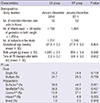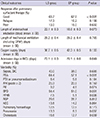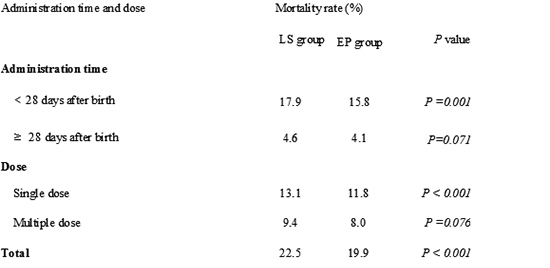Abstract
Figures and Tables
Table 1

Table 2

BPD, bronchopulmonary dysplasia; CPAP, continuous positive airway pressure; DIC, disseminated intravascular coagulation; EP, early prophylactic; IVH, intraventricular hemorrhage; LS, late selective; NEC, necrotizing enterocolitis; NICU, neonatal intensive care unit; PDA, patent ductus arteriosus; PIE, pulmonary interstitial emphysema; PPHN, persistent pulmonary hypertension; PTX, pneumothorax; ROP, retinopathy of prematurity.
Notes
The following 53 hospitals and individuals participated in this study by providing well-designed clinical data of two years (2010 and 2011) for this national study: Ajou University Hospital (Park MS, Lee JJ), Busan St. Mary's Medical Center (Kim SM), CHA Gangnam Medical Center, CHA University (Jeon JH), CHA Bundang Medical Center, CHA University (Lee KH, Cho HS), Cheil General Hospital & Women's Health Care Center (Shin SM), Cheju National University Hospital (Kim YD), Chonbuk National University Hospital (Cho SC), Chonnam National University Hospital (Choi YY, Song ES), Chosun University Hospital (Park SK), Chung Ang University Medical Center (Lee NM), Chungnam National University Hospital (Chang MY), Daegu Catholic University Medical Center (Kim WT), Daegu Fatima Hospital (Kim WD), Dong-A University Hospital (Kim MJ), Eulji General Hospital (Yoon HS), Ewha Womans University Mokdong Hospital (Park EA, Cho SJ), Gachon University Gil Hospital (Shon DW), GangneungAsan Hospital (Jin HS), Gyeongsang National University Hospital (Park CH), Hallym University Kangdong Sacred Heart Hospital (Hwang IT), Hallym University Kangnam Sacred Heart Hospital (Sung TJ), Hallym University Sacred Heart Hospital (Shim EJ), Hanyang University Medical Center (Park HK), Inha University Hospital (Jun YH), Inje University Ilsan Paik Hospital (Hwang JH), Inje University Sanggye Paik Hospital (Chey MJ), Inje University Pusan Paik Hospital (Shin JB), Inje University Seoul Paik Hospital (Park YW), Keimyung University Dongsan Medical Center (Lee SL, Kim CS), Konyang University Hospital (KoKO, Im JW), Korea University Anam Hospital (Lee EH), Korea University Ansan Hospital (Choi BM), Konkuk University Medical Center (Kim MH), Kyunghee University Hospital at Gangdong (Bae CW), Kyunghee University Medical Center (Choi YS), Kyungpook National University Hospital (Kim HM, Park SH), Kwangju Christian Hospital (Kim KS), Pusan National University Hospital (Byun SY), Samsung Medical Center (Park WS, Chang YS, Ahn SY), Seoul National University Bundang Hospital (Kim BI, Choi CW), Seoul National University Children's Hospital (Choi JH, Kim HS), Seoul National University Boramae Medical Center (Lee JA), Soonchunhyang University Bucheon Hospital (Kim SS), Hospital of Sungae (Kim ER), Soonchunhyang University Seoul Hospital (Lee WY), The Catholic University of Korea Seoul St. Mary's Hospital (Sung IK), The Catholic University of Korea St. Mary's Hospital (Kim SY), The Catholic University of Korea St. Vincent's Hospital (Lee JH), Ulsan University Hospital (Oh KW), University of Ulsan Asan Medical Center (Kim KS, Kim ER), Wonkwang University Hospital (Oh YK), Yonsei University Severance Children's Hospital (Namgung R, Eun HS), Yonsei University Gangnam Severance Hospital (Lee SM), Yonsei University Wonju Severance Christian Hospital (Lim BK).




 PDF
PDF ePub
ePub Citation
Citation Print
Print





 XML Download
XML Download